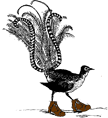Bushfire and Fire Risk - Bushwalking Victoria
Fire Danger Period
CFA declares the Fire Danger Period for each municipality in the lead up to the fire season, depending on the amount of rain, grassland curing rate and other local conditions. The Fire Danger Period may be declared as early as October in some municipalities, and typically remains in place until the fire danger lessens, which could be as late as May.
Local municipalities may have their own local laws in relation to lighting fires. These local laws may be in place throughout the year. Contact the local council to find out what local laws may be in place.
Once the Fire Danger Period has been declared, fire restrictions come into force. This means you cannot light a fire, including a camp fire, in the open air unless you have a permit or comply with certain requirements.
Check whether a Fire Danger Period has been declared at http://www.cfa.vic.gov.au/warnings-restrictions/restrictions-during-the-fire-danger-period/.
Victoria's parks and forests in bushfire prone areas are closed to the public on Code Red days. For more information, go to https://www.ffm.vic.gov.au/permits-and-regulations/closures-of-parks-and-forests
Total Fire Ban days
Total Fire Bans are different to the Fire Danger Period. A Total Fire Ban Day can be declared at any time during the year. No fires are to be lit in the open air on Total Fire Ban Days unless you have a special permit.
Check Total Fire Bans for Victoria athttp://www.cfa.vic.gov.au/warnings-restrictions/total-fire-bans-and-ratings/.
Fire Danger Ratings
The Fire Danger Rating predicts how a fire is likely to behave once started and how difficult it would be to put out. The higher the rating, the more dangerous the conditions. For information about Fire Danger Ratings, go to:
http://www.cfa.vic.gov.au/fm_files/attachments/warnings_and_restrictions/fire_danger_rating.pdf.
Two components of the Fire Danger Rating are the Forest Fire Danger Index (FFDI) and Grass Fire Danger Index (GFDI). The FFDI is calculated using a Drought Factor Value calculated by the Bureau of Meteorology (BoM) based on either the Keetch Byram Drought Index or the Mount Soil Dryness Index. The GFDI is calculated using grass curing and fuel load data supplied by the Fire Authority.
You can view maps of the FFDI and GFDI athttp://www.bom.gov.au/vic/forecasts/fire-map.shtml. These maps are updated twice a day at approximately 6am and 6pm during the fire season. (The maps are not available outside the fire season.) The maps may not reflect the latest official forecasts which can be updated at any time. The maps must never be used as your sole source of information.
Always use these maps together with the BoM's warnings and weather forecasts and with Fire Danger Ratings issued by the CFA.
Local Warnings
The CFA publishes a map showing the location of warnings and incidents of fires of all types and of burn-offs (together with other emergencies) at http://www.cfa.vic.gov.au/warnings-restrictions/warnings-and-incidents/.
Planned Burns
DELWP and Parks Victoria do planned burns in parks and forests, both near communities and in remote areas. The CFA helps and does planned burns on private land.
DELWP publishes information about planned burns for a 10-day period at https://www.ffm.vic.gov.au/bushfire-fuel-and-risk-management/planned-burns
Sources:
http://www.bom.gov.au/vic/
http://www.cfa.vic.gov.au
https://www.ffm.vic.gov.au/
Fire Risk & Bushfire
Prevention
The best way to avoid danger from a bushfire is to avoid walking at high risk times and locations. Before leaving home, check the weather forecast and fire restrictions. Minimize the use of campfires at any time and always take extreme care when lighting fires.
Action
If caught walking in the path of a bushfire:
- Call Triple Zero 000
- Move to a cleared area. You can’t outrun a fire. Look for shelter in rocks, hollows, embankments, streams or roads. Do not hide in water tanks. Remember that radiant heat can be as deadly as flames.
- Head to a lower area, not uphill, as a bushfire will rapidly ascend from valleys to ridges.
- Drink plenty of water and cover your mouth with a damp cloth.
- Keep low and cover your skin.
- Move to burnt ground once the fire has passed.
- As a last resort only you may need to run through the flames to a burnt out area. Choose a relatively clear area where flames are less than a metre high, take a deep breath, cover your face and run.
- Contact someone to let them know your situation as soon as possible.
Where can I find bushfire warnings?
|
NSW & ACT |
NSW Rural Fire Service publish details of bushfires and hazard reduction burns online. Download the NSW Rural Fire Service Fires near Me app on iTunes or Android for information on the go in New South Wales and the ACT. |
|
VIC |
Vic Emergency lists all Victorian emergency warnings. You can also download the FireReady app from this site. FireReady is the official Victorian Government app for access to timely, relevant and tailored bushfire warnings and information in Victoria. |
|
QLD |
Rural Fire Service Queensland lists bushfire warnings with an interactive map. |
|
SA |
The South Australian Country Fire Service lists incidents and warnings on its website. CFS FireApp is the official South Australian Country Fire Service iPhone and Android application. |
|
TAS |
Tasmania Fire Service lists bushfire warnings with an interactive map. |
|
WA |
Western Australia Emergency WA features an interactive map with cyclone, flood and bush fire warnings. |
|
NT |
ABC Emergency is the official broadcaster for fire and emergency warnings. |
|
NZ |
New Zealand National Rural Fire Authority displays a daily fire danger map. Met Service lists New Zealand official weather forecasts and weather warnings. |
